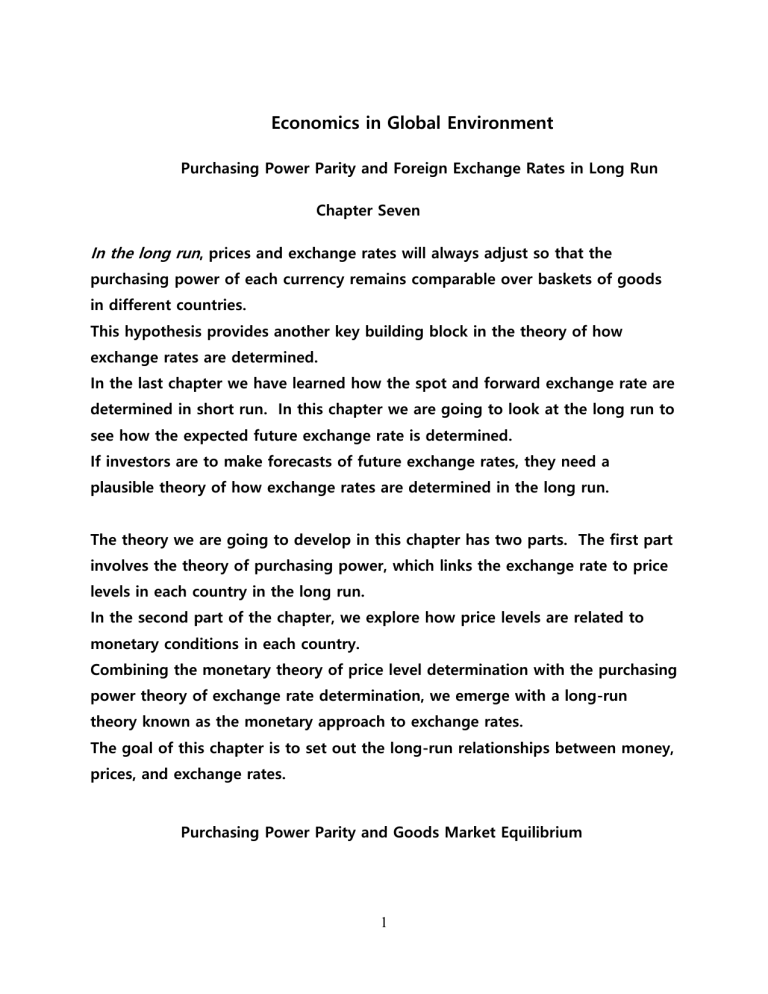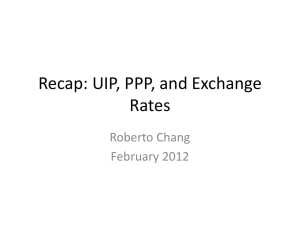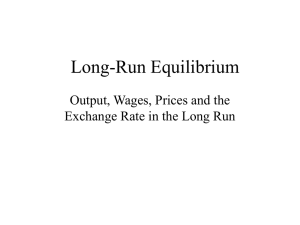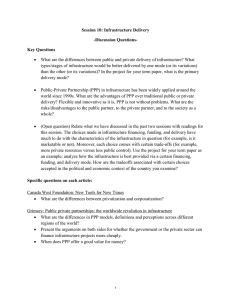
Economics in Global Environment Purchasing Power Parity and Foreign Exchange Rates in Long Run Chapter Seven In the long run, prices and exchange rates will always adjust so that the purchasing power of each currency remains comparable over baskets of goods in different countries. This hypothesis provides another key building block in the theory of how exchange rates are determined. In the last chapter we have learned how the spot and forward exchange rate are determined in short run. In this chapter we are going to look at the long run to see how the expected future exchange rate is determined. If investors are to make forecasts of future exchange rates, they need a plausible theory of how exchange rates are determined in the long run. The theory we are going to develop in this chapter has two parts. The first part involves the theory of purchasing power, which links the exchange rate to price levels in each country in the long run. In the second part of the chapter, we explore how price levels are related to monetary conditions in each country. Combining the monetary theory of price level determination with the purchasing power theory of exchange rate determination, we emerge with a long-run theory known as the monetary approach to exchange rates. The goal of this chapter is to set out the long-run relationships between money, prices, and exchange rates. Purchasing Power Parity and Goods Market Equilibrium 1 Just as arbitrage occurs in the international market for financial assets, it also occurs in the international markets for goods. The result of goods market arbitrage is that the prices of goods in different countries expressed in a common currency tend to be equalized. Applied to a single good, this idea is referred to as the “law of one price” applied to an entire basket of goods, it is called the theory of “purchasing power parity.” Our goal is to develop a simple yet useful theory based on an idealized world of frictionless trade where transaction costs can be neglected. We start at the microeconomic level with single goods and the law of one price. We then move to the macroeconomic level to consider baskets of goods and purchasing power parity. Law of One Price The law of one price (LOOP) states that in the absence of trade frictions (such as transport costs and tariffs), and under conditions of free competition and price flexibility (where no individual sellers or buyers have power to manipulate prices and prices can freely adjust), identical goods sold in different locations must sell for the same price when prices are expressed in a common currency. By definition, in a market equilibrium there are no arbitrage opportunities. If gold can be freely moved between New York and London, both markets must offer the same price. Economists refer to this situation in the two locations as an integrated market. The exchange rate between two currencies should equal to the ratio of the countries’ price levels: When the “Law of One Price” is applied internationally to a standard consumption basket, we obtain the theory of “Purchasing Power Parity (PPP).” This theory states that the exchange rate between two currencies of two countries should be equal to the ratio of the countries’ price levels. 2 $ 𝑷$ £ 𝑷 S( )= £ For example, if an ounce of gold costs $300 in the U.S. and £150 in the U.K., then the price of one pound in terms of dollars should be: $ 𝑷$ £ 𝑷 S( )= = £ $𝟑𝟎𝟎 £𝟏𝟓𝟎 = $𝟐 £𝟏 Suppose the spot exchange rate is $1.25 = €1.00. If the inflation rate in the U.S. is expected to be 3% in the next year and 5% in the euro zone, then the expected exchange rate in one year should be $1.25×(1.03) = €1.00×(1.05). Inflation is the rate of increase in prices over a given period of time. Inflation is typically a broad measure, such as the overall increase in prices or the increase in the cost of living in a country. The euro will trade at a 1.90% discount in the forward market based Forward/spot price relationship and PPP theory: $ $𝟏.𝟐𝟓∗(𝟏.𝟎𝟑) 𝑭( ) € $ 𝑺( ) € = €𝟏.𝟎𝟎∗(𝟏.𝟎𝟓) $𝟏.𝟐𝟓 €𝟏.𝟎𝟎 = 𝟏.𝟎𝟑 𝟏.𝟎𝟓 = 𝟏+ 𝝅$ 𝟏+ 𝝅 € Relative PPP states that the rate of change in the exchange rate is equal to differences in the rates of inflation—roughly 2%= 5% - 3% Absolute PPP and Relative PPP Absolute PPP: The same basket of goods should cost the same everywhere. If a standard basket of goods costs €100.00, and the USD/EUR exchange rate is $1.3158/€, then that standard basket of goods should cost $131.58 in U.S. 3 Relative PPP: The exchange rates between currencies should reflect their inflation rates. If the spot USD/EUR exchange rate is $1.3158/€, the (annual) USD inflation rate is 4% and the (annual) EUR inflation rate is 2%, then the expected spot exchange rate in one year later should be ($1.3158 × 1.04) / (€1 × 1.02) = $1.3416/€. PPP and IRP Notice that our two big equations equal each other: PPP IRP $ $ 𝑭( ) € = $ 𝑺( ) € 𝟏+ 𝝅$ 𝟏+ 𝝅 𝟏+ 𝒊$ = 𝟏+ 𝒊 € € 𝑭( ) = € $ 𝑺( ) € Expected Rate of Change in Exchange Rate as Inflation Differential We could also reformulate our equations as inflation or interest rate differentials: $ 𝑭( ) € $ 𝑺( ) 𝟏+ 𝝅$ = 𝟏+ 𝝅 € 𝑭( $ € € $ )− 𝑺 ( ) € $ 𝑺( ) = € 𝑭( E(e)= $ € 𝟏+ 𝝅$ 𝟏+ 𝝅 -1= € $ )− 𝑺 ( ) € $ 𝑺( ) € = 𝟏+ 𝝅$ 𝟏+ 𝝅 𝝅$− 𝝅 𝟏+ 𝝅 4 € € € - 𝟏+ 𝝅 𝟏+ 𝝅 € € ≒ 𝝅$− 𝝅 € 𝑭( E(e)= $ € $ )− 𝑺 ( ) € $ 𝑺( ) = € 𝒊$− 𝒊 𝟏+ 𝒊 € ≒ 𝒊$− 𝒊 € € 𝝅$− 𝝅 € ≒ 𝒊$− 𝒊 € PPP Deviations and the Real Exchange Rate: Whether PPP holds or not has important implication for international trade. If PPP holds and thus the differential inflation rates between countries are exactly offset by exchange rate changes, countries’ competitive positions in world export markets will not be systematically affected by exchange rate changes. However, if there are deviations from PPP, changes in nominal exchange rates cause changes in the “real exchange rates”, affecting the international competitive positions of countries. This, in turn, would affect countries’ trade balances. The real exchange rate, q, which measures deviations from PPP, can be defined as follows: g = ( E$ / € PEUR )/ g qUS / EUR Relative price of good g in Europe versus U.S. European price of good g in $ PUSg U.S. price of good g in $ First, note that if PPP holds (PPP conditions are met/satisfied), that is, 𝑬 𝑷𝑬𝑼𝑹=𝑷𝑼𝑺 , the real exchange rate will be unity, q = 1. 𝒈 $/€ 𝒈 When PPP is violated, however, the real exchange rate will deviate from unity. Suppose, for example, the annual inflation rate is 5% in the U.S and 3.5% in the euro zone, and the spot dollar/euro rate is 1.009. Then the real exchange rate is 0.99: q = (1.009)*(1.035)/(1.05) = 0.99 5 In the above example, the dollar depreciated by more than is warranted by PPP, strengthening the competiveness of U.S industries in the world market. If the dollar depreciates by less than the inflation rate differential, the real exchange rate will be greater than unity. Weakening the competitiveness of U.S industries. To summarize, q = 1 : Competitiveness of the domestic country unaltered. q < 1 : Competitiveness of the domestic country improves. q > 1 : Competitiveness of the domestic country deteriorates. Or put it another way, (1) If the real exchange rate q US/BP is below 1 by x%, then Foreign (UK) goods are relatively cheap, x% cheaper than Home (US) goods. In this case, the Home currency (the dollar) is said to be strong, the British Pound is weak, and we say the B Pound is undervalued by x%. (2) If the real exchange rate q US/BP is above 1 by x%, then Foreign goods are relatively expensive, x% more expensive than Home goods. In this case, the Home currency (the dollar) is said to be weak, the euro is strong, and we say the euro is overvalued by x%. The relative price of the baskets is one of the most important variables in international macroeconomics, and it has a special name: it is known as the real exchange rate. The U.S. real exchange rate q US/EUR =E $/€ P EUR /P US tells us how many U.S. baskets are needed to purchase one European basket; it is the price of the European basket in terms of the U.S. basket. The exchange rate for currencies is a nominal concept. The real exchange rate is a real concept; it says how many U.S. baskets can be exchanged for one European basket. 6 The real exchange rate has some terminology similar to that used with the nominal exchange rate: (1) If the real exchange rate rises (more Home goods are needed in exchange for Foreign goods), we say Home has experienced a real depreciation. (2) If the real exchange rate falls (fewer Home goods are needed in exchange for Foreign goods), we say Home has experienced a real appreciation. Evidence on PPP PPP probably does not hold precisely in the real world for a variety of reasons. Haircuts cost 10 times as much in the developed world as in the developing world. Film, on the other hand, is a highly standardized commodity that is actively traded across borders. Shipping costs, as well as tariffs and quotas, can lead to deviations from PPP. PPP-determined exchange rates still provide a valuable benchmark. Economists have found a variety of reasons why PPP fails in the short run: (1) Transaction costs. Include costs of transportation, tariffs, duties, and other costs due to shipping and delays associated with developing distribution networks and satisfying legal and regulatory requirements in foreign markets. On average, they are more than 20% of the price of goods traded internationally. (2) Nontraded goods. Some goods are inherently nontradable; they have infinitely high transaction costs. Most goods and services fall somewhere between tradable and nontradable. (3) Imperfect competition and legal obstacles. Many goods are not simple undifferentiated commodities, as LOOP and PPP assume, but are differentiated products with brand names, copyrights, and legal protection. Such 7 differentiated goods create conditions of imperfect competition because firms have some power to set the price of their good. With this kind of market power, firms can charge different prices not just across brands but also across countries. (4) Price stickiness. Prices do not or cannot adjust quickly and flexibly to changes in market conditions. The Exact Fisher Effects Fisher Effects An increase (decrease) in the expected rate of inflation will cause a proportionate increase (decrease) in the interest rate in the country. For the U.S., the Fisher effect is written as: 1 + i$ = (1 + $ ) × E(1 + $) Where: $ is the equilibrium expected “real” U.S. interest rate. E($) is the expected rate of U.S. inflation. i$ is the equilibrium expected nominal U.S. interest rate. International Fisher Effect If the Fisher effect holds in the U.S., 1 + i$ = (1 + $ ) × E(1 + $) and the Fisher effect holds in Japan, 1 + i¥ = (1 + ¥ ) × E(1 + ¥) and if the real rates are the same in each country (empirical studies show that real interests among nations are similar to each other), so we can safely assume $ = ¥ then we get the International Fisher Effect: 8 𝟏 + 𝒊¥ 𝟏 + 𝒊$ 𝑬(𝟏 + ¥) = 𝑬(𝟏 + $) If the International Fisher Effect holds, 𝟏 + 𝒊¥ 𝟏 + 𝒊$ 𝑬(𝟏 + ¥) = 𝑬(𝟏 + $) and if IRP also holds 𝑭 𝟏 + 𝒊¥ 𝟏 + 𝒊$ = ¥⁄ $ 𝑺 ¥⁄ $ then forward rate PPP holds: 𝑭 ¥⁄ $ 𝑺 ¥⁄ = 𝑬(𝟏 + ¥) 𝑬(𝟏 + $) $ 9


